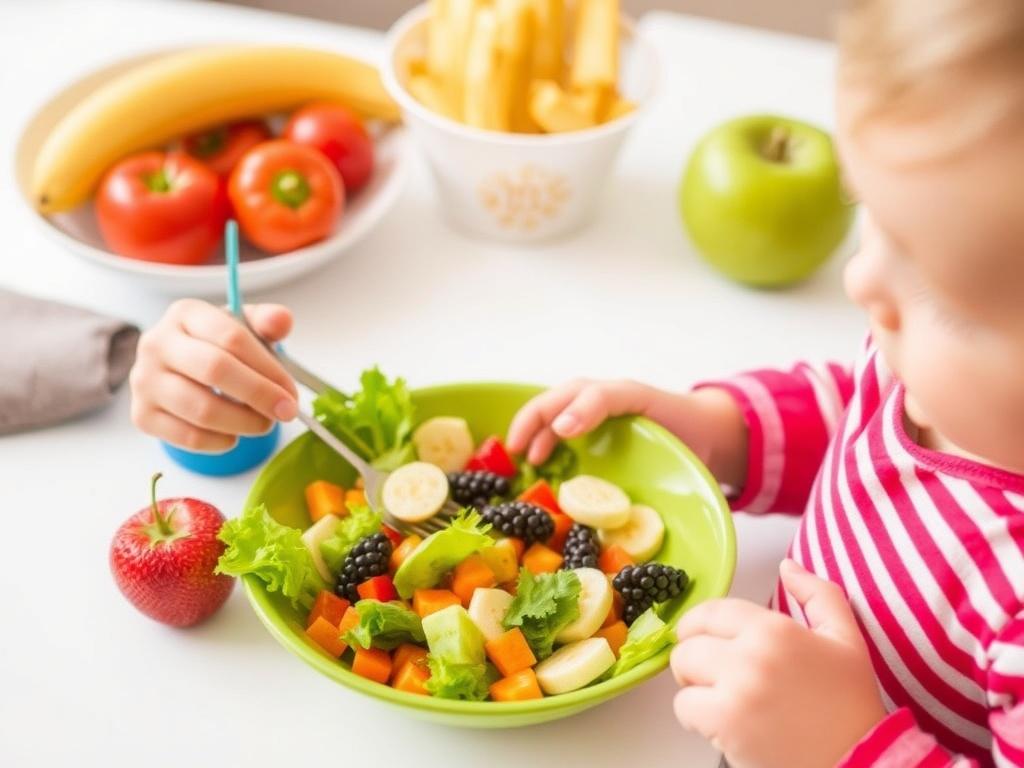SQLITE NOT INSTALLED
Welcome! If you are here, you probably care deeply about helping the children in your life grow up healthy, strong, and happy. That desire is the driving force behind every choice you make about food, snacks, and mealtimes. In this article I will walk you step by step through what healthy eating for children looks like in real life — not as a rigid set of rules but as a set of simple, flexible habits that fit into busy family routines. Gesunde Ernährung für Kinder leicht gemacht — healthy eating for children made easy — is the promise I want to help you keep.
This is a long, practical article filled with explanations, examples, age-appropriate guidance, sample meal plans, recipes, shopping tips, and strategies for picky eaters. I’ll keep the language simple and the ideas achievable so you can pick what works for your family and leave the rest. Everything here is about balance, variety, and building positive relationships with food that last a lifetime.
Why Gesunde Ernährung für Kinder leicht gemacht matters
Healthy eating during childhood does more than provide energy for the day. It supports growth, brain development, immune function, mood regulation, sleep quality, and the foundations of long-term health. The foods children eat now form taste preferences and habits that often persist into adulthood. That’s why focusing on balanced, enjoyable meals is one of the best investments parents and caregivers can make.
But “healthy” shouldn’t be overwhelming. It’s not about perfection. Small, consistent improvements matter far more than dramatic but unsustainable changes. Gesunde Ernährung für Kinder leicht gemacht is about making the nutritious choice the easy choice — in the grocery aisle, in the kitchen, and at the table.
Core principles: Simple rules to guide everyday choices
Before we dive into menus and recipes, let’s set up a few guiding principles that will make decisions easier. Think of these as the pillars of a child-friendly healthy diet.
- Variety over perfection: Aim to offer a wide range of foods over days and weeks. Different foods provide different nutrients, and exposure builds acceptance.
- Balance each day: Include foods from the major groups — vegetables and fruits, whole grains, lean proteins, and dairy or fortified alternatives — across meals and snacks.
- Hands-on learning: Involve children in shopping, cooking, and serving to build skills and positive associations with food.
- Regular routines: Family meals, consistent snack times, and predictable structure help regulate appetite and reduce grazing on processed foods.
- Be a role model: Children mimic adults. Eating a variety of healthy foods yourself is one of the most powerful influences on what they will choose.
With these simple rules, you can adapt recommendations to allergies, cultural preferences, budgets, and schedules. Next, we’ll look at the building blocks of everyday meals.
Understanding food groups: Building blocks of a balanced plate
To create meals that are both nutritious and satisfying, it helps to think in food groups rather than strict calorie counting. Below is a practical table showing common food groups, why they matter, and child-friendly examples you can use every week.
| Food Group | Why It Matters | Child-Friendly Examples |
|---|---|---|
| Vegetables | High in vitamins, minerals, fiber; support digestion and immune system | Carrot sticks, steamed broccoli, cherry tomatoes, sweet potato cubes, spinach in smoothies |
| Fruits | Provide vitamins, fiber, natural sweetness, and hydration | Bananas, berries, apple slices, mango, orange segments |
| Whole Grains | Energy, fiber, B vitamins; help keep children full and focused | Oats, brown rice, whole-wheat pasta, whole-grain bread, quinoa |
| Protein | Essential for growth, muscle repair, and development | Lean meats, poultry, fish, eggs, beans, lentils, tofu, Greek yogurt |
| Dairy & Alternatives | Calcium and vitamin D for strong bones; protein | Milk, yogurt, cheese, fortified plant milks, fortified soy products |
| Fats (Healthy) | Essential for brain development and vitamin absorption | Avocado, olive oil, nut butter, seeds, fatty fish like salmon |
Use this table as a guide when planning meals. A simple rule of thumb is to aim for at least three food groups at most meals and two at snacks. That combination helps provide energy, keep kids satisfied, and deliver the broad nutrients they need.
Portion guidance and age-appropriate expectations
Portions for children are smaller than those for adults, and they vary widely by age, activity level, and growth rate. Rather than strict measurements, try these simple, child-friendly portion cues:
- 1–3 years: Use the child’s hand: one to two tablespoons of cooked veggies per year of age (e.g., 2–6 tablespoons total), one small fist of grains or starch, and one to two ounces of protein spread across meals.
- 4–8 years: Offer roughly 1/2 to 3/4 of an adult portion. Think 1/2 to 3/4 cup of cooked grains, 1/2 cup fruits or veggies, and about 2–3 ounces of protein.
- 9–13 years: Growing children need more energy: offer near-adult portions depending on appetite and activity — about 3/4 to full cups of grains, 1 cup vegetables, and 3–4 ounces protein.
- Teens: Teenagers vary greatly. Follow appetite cues and include healthy snacks; focus on full meals with balanced components.
Remember: appetite varies from day to day. Trust a child’s internal hunger and fullness cues rather than forcing clean plates. Encouraging but not coercing children to try new foods helps them develop autonomy and a healthy relationship with food.
Practical portion table
| Age Group | Vegetables/Fruit (per meal) | Grains/Starches | Protein | Dairy/Alternative |
|---|---|---|---|---|
| 1–3 years | 2–4 tbsp | 1/4–1/2 cup | 1–2 oz | 1/2 cup milk or yogurt |
| 4–8 years | 1/4–1/2 cup | 1/2 cup | 2–3 oz | 1/2–1 cup |
| 9–13 years | 1/2–1 cup | 3/4–1 cup | 3–4 oz | 1–1.5 cups |
| 14–18 years | 1–2 cups | 1–2 cups | 4–6 oz | 1.5–2 cups |
These are general guidelines, not strict rules. Pay attention to growth charts and pediatric guidance for individualized needs.
Meal structure: Breakfast, lunch, dinner, and snacks
Children thrive on routine. Structuring three balanced meals with one or two planned snacks helps prevent overeating of convenience foods and supports steady energy throughout the day. Here’s a simple framework for each eating occasion.
Breakfast: Fuel for learning and focus
Breakfast should combine carbohydrates for immediate energy, protein to maintain focus and fullness, and a fruit or vegetable for vitamins and fiber. A few examples:
- Oatmeal with milk, sliced banana, and a sprinkle of nuts or seeds.
- Whole-grain toast with peanut butter and apple slices.
- Greek yogurt with berries and a small handful of granola.
- Scrambled eggs and whole-grain tortilla with salsa and avocado.
If mornings are rushed, prepare components the night before — pre-chop fruit, portion out yogurt, or make overnight oats.
Lunch: Balanced and transportable
School lunches often need to travel. Focus on protein, whole grains, and fruits/vegetables. Add a small dairy or alternative if desired. Examples:
- Whole-grain sandwich with turkey, cheese, and lettuce; carrot sticks; kiwi wedges.
- Bean and rice bowl with chopped peppers and a side of orange segments.
- Pasta salad with peas, cherry tomatoes, cubes of cheese, and a side of grapes.
Make lunches appealing: use colorful containers, include a dip like hummus, and add an unexpected treat like a small dark chocolate square occasionally.
Dinner: Family time and variety
Dinner is a chance to model balanced eating and enjoy family connection. Aim to include vegetables, a grain or starch, and a protein. Examples:
- Grilled salmon, quinoa, and roasted broccoli.
- Stir-fried tofu with mixed vegetables and brown rice.
- Whole-wheat spaghetti with marinara and turkey meatballs, plus a side salad.
Let children help set the table, serve themselves, or choose side veggies to increase participation.
Snacks: When planned, they’re helpful
Snacks are part of a healthy eating pattern if they are balanced — not just sugary or salty treats. Keep snacks to two nourishing components (for example, fruit plus protein). Snack ideas:
- Apple slices with cheese.
- Carrot sticks with hummus.
- Whole-grain crackers with tuna salad.
- Yogurt with sliced fruit.
Timing matters: offer snacks between 2–3 hours after a meal so hunger cues still work. Avoid grazing all day.
Sample weekly meal plan: Simple, flexible, and family-friendly
Here’s a sample week to inspire you. Remember to swap meals based on preferences, allergies, and cultural foods
| Day | Breakfast | Lunch | Snack | Dinner |
|---|---|---|---|---|
| Monday | Whole-grain toast, scrambled egg, orange slices | Turkey & cheese wrap, cucumber sticks, yogurt | Banana with a small spoon of peanut butter | Grilled chicken, sweet potato wedges, steamed green beans |
| Tuesday | Overnight oats with berries | Pasta salad with peas and cherry tomatoes, apple | Carrot sticks and hummus | Vegetable stir-fry with tofu and brown rice |
| Wednesday | Greek yogurt with granola and sliced kiwi | Bean & cheese burrito, side of salsa and bell pepper strips | Whole-grain crackers with cheese | Baked salmon, quinoa, roasted broccoli |
| Thursday | Whole-grain pancake, blueberries, milk | Chicken salad on whole-grain bread, carrot sticks | Grapes and a handful of almonds (age-appropriate) | Homemade chili with mixed beans, brown rice |
| Friday | Smoothie with spinach, banana, yogurt, and oats | Mini pita pockets with tuna salad and cucumber slices | Apple slices with sunflower seed butter | Homemade pizza on whole-wheat crust with vegetable toppings |
| Saturday | Egg and veggie muffin cups, melon | Grilled cheese on whole-grain bread, tomato soup | Trail mix (age-appropriate) | BBQ chicken, corn on the cob, coleslaw |
| Sunday | French toast with berry compote | Leftover chili with a whole-grain roll | Cottage cheese with pineapple | Family-style taco night with lots of veggies and beans |
Use leftovers creatively to save time. Whenever possible, include your child in choosing one new meal a week — their investment increases willingness to eat it.
Practical shopping tips: How to make the grocery store your ally

Shopping smarter saves time and reduces stress at home. Here are practical tips to shop for healthy, kid-friendly food without breaking the bank.
- Make a list and stick to it: Plan meals for a few days and buy ingredients in one trip to reduce impulse purchases.
- Shop the perimeter: Fresh produce, dairy, meat, and whole grains are usually around the store edge; processed snacks are often inside the aisles.
- Buy seasonal produce: It’s often cheaper, tastier, and more nutritious.
- Frozen fruits and vegetables are great: They’re convenient, last longer, and freeze-flash preserving keeps nutrients intact.
- Choose whole grains: Look for “whole” as the first ingredient (e.g., whole-wheat flour, whole oats).
- Read labels wisely: For packaged foods, compare serving sizes, sugar and sodium content, and choose lower-sodium and lower-sugar options when possible.
Shopping with children can be an excellent teaching moment — let them pick a new fruit to try or help compare cereal boxes to practice reading labels.
Kitchen and cooking tips: Simple ways to make meals kid-friendly
Cooking at home often yields more nutritious meals and is a powerful way to model positive eating habits. Here are easy strategies to involve children and make cooking less daunting.
- Batch-cook and freeze: Make large portions of soups, casseroles, and cooked grains, then freeze in child-sized portions for busy days.
- Prep once, use twice: If you chop a whole batch of vegetables, use them in salads, stir-fries, snacks, and omelets throughout the week.
- Make veggies appealing: Roasting increases sweetness; dips like yogurt or hummus make raw veggies more enticing.
- Offer build-your-own meals: Bowls, wraps, and taco nights let children assemble their plate, giving them control and making meals fun.
- Use colorful plates and shapes: Bright produce cut into fun shapes can tempt hesitant eaters without pressure.
- Keep utensils age-appropriate: Safe knives for kids, silicone spatulas, and small measuring cups can help children help.
Even small tasks like stirring, rinsing produce, or sprinkling cheese can build confidence and curiosity about food.
Picky eaters: Patient strategies that work
Picky eating is common and usually temporary, but it can be stressful. The good news: with patience and consistency, most kids expand their diets. Here are research-backed tactics presented in friendly, actionable terms.
1. Repeated exposure
Children often need to see or taste a new food many times — sometimes 10–15 exposures — before accepting it. Keep offering the food without pressure and celebrate small wins, like touching or smelling it.
2. Pair new foods with liked foods
Place a tiny portion of a new food alongside a favorite. For example, if your child loves pasta, add a small side of roasted vegetables rather than forcing them to eat only vegetables.
3. Make small portions and build up
Serve a small amount of the new food so it doesn’t overwhelm the plate. If they try it, offer praise and a little more next time.
4. Avoid food battles
Pressuring children to eat or threatening consequences often backfires. Instead, establish routines and let children decide how much to eat from what’s offered.
5. Be creative and persistent
Change textures, cooking methods, or presentation. If raw broccoli is rejected, try it steamed, roasted, or in a cheesy pasta. Persistence combined with creativity usually pays off.
6. Model adventurous eating
Eat the new foods yourself and show enjoyment. Kids are more likely to try what they see adults enjoying.
Recipes: Easy, kid-approved dishes you can make tonight
Here are several easy, nutritious recipes with simple steps. Each recipe is written to be flexible — swap ingredients for allergies or preferences as needed.
1. Rainbow Veggie Pasta
This colorful pasta hides a variety of vegetables and is a favorite among kids and adults alike.
- Ingredients:
- 250 g whole-grain pasta
- 1 cup cherry tomatoes, halved
- 1 cup spinach, roughly chopped
- 1 medium carrot, grated
- 1 small zucchini, diced
- 1/2 cup shredded cheese (optional)
- 1–2 tbsp olive oil
- Salt and pepper to taste
- Method:
- Cook pasta according to package instructions. Reserve 1/2 cup cooking water and drain.
- While pasta cooks, sauté zucchini and grated carrot in olive oil for 3–4 minutes until softened. Add cherry tomatoes and spinach and cook until wilted.
- Toss pasta with the vegetables, add reserved cooking water if needed, and sprinkle with cheese. Serve warm.
2. Easy Chicken and Veggie Sheet Pan
Perfect for busy nights — throw everything on a tray and roast.
- Ingredients:
- 4 chicken thighs or breasts
- 2 cups sweet potato cubes
- 2 cups broccoli florets
- 1 tbsp olive oil
- 1 tsp paprika, 1/2 tsp garlic powder, salt and pepper
- Method:
- Preheat oven to 200°C (400°F). Toss vegetables in olive oil and seasonings. Place on a baking sheet.
- Season chicken and place on the sheet. Roast for 25–30 minutes until chicken is cooked through and vegetables are tender.
- Serve with a squeeze of lemon if desired.
3. Hidden Veggie Smoothie
A great way to serve extra greens, especially at breakfast or as a snack.
- Ingredients:
- 1 cup milk or fortified plant milk
- 1/2 cup plain yogurt
- 1 banana
- 1 cup mixed berries (fresh or frozen)
- 1 handful baby spinach or kale (mild flavor)
- 1 tbsp nut or seed butter (optional)
- Method:
- Blend all ingredients until smooth. Serve immediately. The fruit masks the taste of greens for most children.
Healthy snack ideas: Quick, nutritious choices
Snacks should be small and balanced. Here’s a table of easy options to rotate through the week.
| Snack | Components | Why it works |
|---|---|---|
| Apple slices + cheese | Fruit + protein | Fiber and protein keep kids satisfied |
| Yogurt + berries | Dairy + fruit | Calcium and antioxidants |
| Whole-grain crackers + hummus | Grain + protein | Filling and portable |
| Carrot sticks + nut/seed butter | Veg + healthy fat | Crunchy and satisfying |
| Boiled egg + cherry tomatoes | Protein + veg | Simple and nutrient dense |
Rotate snacks to keep them interesting and avoid relying on packaged items every day.
Limiting sugar and processed foods without drama
Completely banning sweets often makes them more desirable. Instead, reduce frequency and portion sizes of sugary snacks and drinks while offering appealing, nutritious alternatives. Here’s a practical approach:
- Keep treats occasional: Reserve sweets for celebrations or once or twice a week. Make special snacks part of a larger, balanced meal when they do appear.
- Choose lower-sugar versions: Swap sugary cereals for whole-grain ones, flavor yogurt with fresh fruit rather than syrup.
- Cut back on sugary drinks: Water and milk should be primary beverages. Reserve juice to a small serving (and preferably diluted) and avoid sugary sodas entirely for young children.
- Make healthful versions: Homemade muffins with less sugar, fruit-based desserts, and yogurt bark are satisfying without excess sugar.
These gentle changes lower sugar intake while keeping mealtimes positive and realistic.
Allergies and intolerances: Safe, nutritious swaps
Food allergies and intolerances require careful management, but they don’t mean compromise on nutrition or enjoyment. If a child has a diagnosed allergy, follow medical guidance first. Here are practical swaps for common problems:
- Milk allergy or lactose intolerance: Use fortified plant milks (soy provides more protein than some alternatives), almond milk, oat milk, or lactose-free dairy. Ensure calcium and vitamin D intake through alternatives and foods like leafy greens, tofu, or fortified cereals.
- Nut allergy: Replace nut butters with seed butters (sunflower, pumpkin) where appropriate. Read labels carefully since cross-contamination is an issue in some products.
- Gluten intolerance or celiac disease: Choose naturally gluten-free grains like rice, quinoa, buckwheat, and gluten-free whole-grain breads and pastas. Ensure variety to meet fiber and vitamin needs.
Work with a dietitian or pediatrician to ensure micronutrients are adequate when major food groups are avoided.
Vegetarian and vegan children: Meeting nutrient needs
Children can thrive on vegetarian or vegan diets if they are thoughtfully planned. Key nutrients to pay attention to include protein, iron, calcium, vitamin B12, vitamin D, and omega-3 fats. Practical tips:
- Protein sources: Beans, lentils, tofu, tempeh, eggs (if lacto-ovo vegetarian), dairy or fortified plant milks.
- Iron: Include lentils, beans, fortified cereals, tofu, and pair with vitamin C-rich foods (tomatoes, citrus) to improve absorption.
- Calcium & vitamin D: Use fortified plant milks, fortified cereals, leafy greens, and consider supplementation if recommended by a healthcare provider.
- B12: B12 is produced by bacteria and typically absent in plant foods. Fortified foods or supplements are often necessary for vegan children.
- Omega-3s: Include flaxseed, chia, walnuts, and consider algae-based supplements for long-chain omega-3s if advised.
Periodic bloodwork and consultation with a pediatric dietitian can ensure nutritional adequacy.
Food safety basics: Protecting little bodies

Food safety matters especially for young children whose immune systems are still developing. Here are essential food-safety rules to follow at home:
- Avoid honey under 1 year: Honey can contain spores that cause infant botulism, so do not give it to children under 12 months.
- Watch choking hazards: Cut grapes, hot dogs, carrots, and raw apples into small pieces for young children; consider steaming hard vegetables until soft.
- Keep cold foods cold and hot foods hot: Refrigerate leftovers promptly and reheat evenly. Discard foods left out two hours or more at room temperature.
- Prevent cross-contamination: Use separate cutting boards for raw meat and vegetables, and wash hands, utensils, and surfaces thoroughly.
- Cook meats to safe temperatures: Use a food thermometer to ensure poultry and ground meats are fully cooked.
Safe food practices reduce risk and make mealtime less stressful.
Helping children develop healthy eating habits — beyond food
Food is part of a broader lifestyle that affects health. These habits reinforce good nutrition and support growth and well-being.
- Regular family meals: Eating together supports language skills, family bonding, and healthier food choices. Try for several shared meals per week.
- Limit screens during meals: Technology distracts from hunger cues and conversation. Encourage interactions instead.
- Encourage physical activity: Active play supports appetite regulation and overall health. Aim for at least an hour of varied activity daily for school-age children when possible.
- Sleep matters: Adequate sleep supports growth and reduces cravings for sugary foods. Establish consistent bedtime routines.
These lifestyle habits make nutrition advice more effective and easier to sustain.
Working with schools and caregivers
Children eat many of their meals and snacks away from home. Partnering with schools and caregivers extends healthy habits and reduces confusion.
- Share your goals: Let teachers and caregivers know about preferences, allergies, and routine snack times.
- Pack balanced lunches: Use insulated containers to keep food at safe temperatures and include a note with reheating instructions if needed.
- Support school wellness policies: Many schools have nutrition standards for meals and fundraising. Participate in committees or conversations to promote healthier options.
- Coordinate celebrations: Offer non-food rewards or have a few healthy treat options for birthdays and holidays to reduce emphasis on sugary items.
Consistency across environments helps children learn and accept healthy choices.
Addressing common concerns

My child refuses entire food groups — what now?
Start small. Offer foods from the missing group in low-pressure ways: incorporate vegetables into soups, smoothies, or sauces. Praise small successes and continue offering choices without forcing them to eat.
My child is overweight — how can I help without shaming?
Focus on healthful habits rather than weight. Emphasize family-wide changes: balanced meals, more fruits and vegetables, less sugary drinks, and increased physical activity. Avoid language that shames or labels; instead, support self-esteem and body-positive habits. Consulting a pediatrician or dietitian can provide individualized support.
How can I reduce food waste while offering variety?
Plan meals using similar ingredients in multiple ways (roast vegetables for dinner, then add to a soup or omelet). Freeze extras in child-sized portions and involve kids in using leftovers creatively. Shopping with a list and realistic plan reduces overbuying.
Sample grocery list: Simple staples to keep on hand
Having staples on hand makes healthy eating easier. Here’s a compact list you can adapt to your family’s needs.
- Fresh fruits: bananas, apples, berries, oranges
- Fresh vegetables: carrots, bell peppers, spinach, broccoli, sweet potatoes
- Whole grains: oats, brown rice, whole-wheat pasta, whole-grain bread
- Proteins: eggs, canned beans, tofu, lean poultry, canned tuna
- Dairy/alternatives: milk or fortified plant milk, yogurt, cheese
- Healthy fats: olive oil, avocado, nut or seed butter
- Frozen vegetables and fruits for convenience
- Herbs, spices, and low-sodium condiments to increase flavor
Adjust quantities depending on family size and preferences, and rotate seasonal produce for variety and value.
Activities and games that teach about food
Learning about food can be fun. Here are activities that build food knowledge and enthusiasm:
- Color plate challenge: Try to make meals with as many different colors of fruits and vegetables as possible.
- Grocery scavenger hunt: Give children a list of items to find using pictures or simple words to build label-reading skills.
- Plant a small garden: Herbs, cherry tomatoes, or lettuce are easy starters and create excitement about eating what they grow.
- Recipe swap: Have children choose a favorite family recipe and help make it for a weeknight.
These playful experiences create curiosity and a positive emotional connection to food.
When to seek help: Signs to consult a professional
Most feeding and nutrition concerns can be managed at home, but certain signs should prompt a conversation with a pediatrician or registered dietitian:
- Rapid weight loss or poor weight gain
- Severe or growing refusal to eat multiple food groups
- Food allergies or reactions to foods
- Frequent stomach pain, vomiting, or other persistent digestion issues
- Concerns about nutrition during chronic illness or special medical conditions
Professionals can assess growth patterns, recommend tests if needed, and create individualized meal plans that meet nutrient needs while respecting family preferences.
Frequently asked questions
How much juice is okay?
Limit juice, especially for young children. If you provide juice, make it 100% fruit juice and keep servings small (no more than 4 ounces per day for toddlers; 4–6 ounces for older children, diluted with water is ideal). Whole fruit is preferred because it includes fiber and less-concentrated sugar.
Are smoothies healthy every day?
Smoothies can be a nutritious option when they include vegetables, fruit, protein (yogurt or nut butter), and a moderate portion. Avoid making smoothies a primary vehicle for sugary juices or ice cream. Smoothies are best as part of a varied diet rather than a daily exclusive.
How do I reduce sodium in my child’s diet?
Cook from scratch when possible, choose low-sodium canned and packaged items, rinse canned beans, and flavor food with herbs, citrus, and spices instead of excess salt.
Long-term perspective: Building habits that last
Healthy eating is a journey, not a one-time fix. Celebrate progress, not perfection. The best outcomes come from consistent, supportive environments that make nutritious choices accessible and enjoyable. Kinder, clearer routines, and positive mealtime experiences teach children to listen to their bodies, enjoy a range of foods, and carry those skills forward into adulthood.
Keep experimenting, stay patient with picky phases, and remember that small, steady changes add up to big results. Gesunde Ernährung für Kinder leicht gemacht — healthy eating for children made easy — is attainable with intention, flexibility, and lots of love.
Quick reference charts and checklists
Daily mealtime checklist
- Include at least one fruit or vegetable at every meal
- Choose whole grains whenever possible
- Include a protein at main meals
- Offer water as the main beverage
- Keep snacks balanced (fruit + protein or grain + protein)
- Offer new foods without pressure and model positive eating
Weekly shopping checklist (printable version)
Use this as a starting point and adapt by family size and preferences:
- Fruits: bananas, apples, berries, seasonal fruit
- Vegetables: carrots, spinach, broccoli, bell peppers, onions
- Proteins: eggs, beans, chicken, tofu, canned tuna
- Grains: oats, brown rice, whole-grain pasta, whole-grain bread
- Dairy/Alternatives: milk, yogurt, cheese, fortified plant milk
- Pantry basics: olive oil, spices, low-sodium broth, canned tomatoes
Final thoughts: Keep it simple, stay consistent
Healthy eating for children doesn’t require perfection, elaborate recipes, or expensive specialty foods. It asks for patience, planning, and the willingness to create positive, predictable mealtime experiences. When parents and caregivers focus on variety, routine, and involvement, children are more likely to develop healthy preferences that last a lifetime. Gesunde Ernährung für Kinder leicht gemacht — healthy eating for children made easy — is about small, achievable steps that become lifelong habits.
Thank you for taking the time to read this comprehensive guide. I hope it offered practical ideas you can use immediately. Try one new strategy this week — maybe involving your child in a simple cooking task or trying a new vegetable in a fun way — and notice how small changes create momentum. You’re shaping health and joy for your child, one meal at a time.
Author’s note
This article is intended to provide general guidance on healthy eating for children. Individual needs vary; consult a pediatrician or registered dietitian for personalized advice, especially when dealing with medical conditions, growth concerns, or food allergies.



